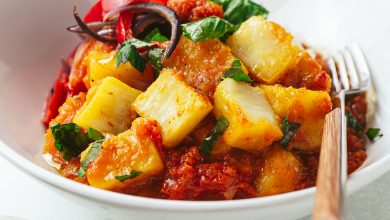Ofada Rice: A Traditional Nigerian Delight
Ofada rice, also known as “Nigerian local rice,” is a popular variety of rice celebrated for its rich, aromatic flavor and unique texture. It is often paired with the famous Ofada stew, also known as Ayamase, making it a staple in Nigerian cuisine. Preparing Ofada rice requires a careful approach to washing and cooking, as it is known for its tendency to contain stones and dirt. Here’s a detailed guide on how to cook Ofada rice perfectly, ensuring it’s both flavorful and fluffy, ideal for pairing with your favorite stew.
Ingredients
| Ingredient | Quantity |
|---|---|
| Ofada Rice | 2 Cups |
| Water | 4 Cups (for initial cooking), 1 Cup (for final cooking) |
| Salt | To taste |
Allergen Information
Ofada rice is naturally gluten-free, making it a great option for those with gluten sensitivity or celiac disease. It is also free of common allergens like dairy, nuts, and soy, making it safe for a variety of dietary needs. However, always check the labels or consult with your supplier to confirm that the rice has been processed in a facility free of cross-contamination with allergens.
Dietary Preferences
- Gluten-Free: Ofada rice is a suitable choice for gluten-free diets.
- Vegan/Vegetarian: When paired with plant-based stews, Ofada rice makes a fantastic option for both vegan and vegetarian diets.
- Halal/Kosher: Ofada rice is permissible for halal and kosher diets, as it is free from animal products and prepared without any forbidden ingredients.
Instructions: How to Cook Ofada Rice Perfectly
-
Prepare the Rice:
- Begin by thoroughly inspecting the Ofada rice for any stones, dirt, or debris. This type of rice is known for being quite dirty, so it’s essential to carefully pick through it before proceeding with the next steps.
- Pour the rice into a bowl and rinse it under cool water. Wash the rice repeatedly, ensuring you get rid of all dirt and particles. Rinse until the water runs clear, indicating that all the impurities have been removed.
-
First Round of Cooking:
- Transfer the rinsed rice into a pot and add 4 cups of water. Allow the rice to cook over low to medium heat for about 12 minutes. It is crucial not to cover the pot during this time, as this will help the rice cook evenly and prevent it from becoming too mushy.
- As the rice cooks, ensure the heat is controlled to avoid burning. You should keep a close watch on the water level to prevent it from drying out.
-
Rinse and Remove Starch:
- Once the initial cooking time has passed, remove the rice from the heat and rinse it again to remove any excess starch. Rinse until the water runs clear. This step is important to ensure that your rice does not turn out overly sticky or clumpy.
-
Second Round of Cooking:
- After rinsing, return the rice to the pot and add 1 cup of fresh water. Continue cooking the rice on low heat. This second round of cooking ensures that the rice cooks through and becomes tender and fluffy. Keep checking on the rice every few minutes to ensure it doesn’t burn or become too soggy.
- Depending on your heat, the cooking time may vary. It usually takes about 10-15 minutes for the rice to fully soften and absorb the water.
-
Final Step:
- Once the rice is tender and fully cooked, remove it from the heat. If you notice any excess water left after cooking, drain the rice in a colander to remove the liquid. This step ensures that your rice is perfectly dry and ready to pair with your favorite stew.
-
Serve and Enjoy:
- Serve the freshly cooked Ofada rice with Ofada stew (Ayamase) for an authentic Nigerian meal. The rice pairs beautifully with the spicy, flavorful stew, making it an unforgettable dish that will impress your guests or satisfy your craving for traditional Nigerian comfort food.
Cooking Tips
-
Rice to Water Ratio: The key to cooking perfect Ofada rice is getting the water-to-rice ratio right. The initial cooking stage uses 4 cups of water to 2 cups of rice, while the final cooking uses just 1 cup of water. This ensures the rice becomes soft without becoming too soggy.
-
Avoid Overcrowding: Ensure you don’t overcrowd the pot with too much rice. Cooking smaller batches will give the rice enough space to cook evenly and absorb the water properly.
-
Watch the Heat: Maintaining a medium to low heat is crucial to avoid burning the rice. Slow cooking helps release the aroma of the rice while keeping the texture intact.
Conclusion
Cooking Ofada rice is an art that requires patience and attention to detail. From rinsing out the dirt to carefully managing the water and heat levels, every step plays a role in achieving the perfect rice. Once you’ve mastered the technique, you’ll have a flavorful and aromatic base for pairing with a rich, spi



